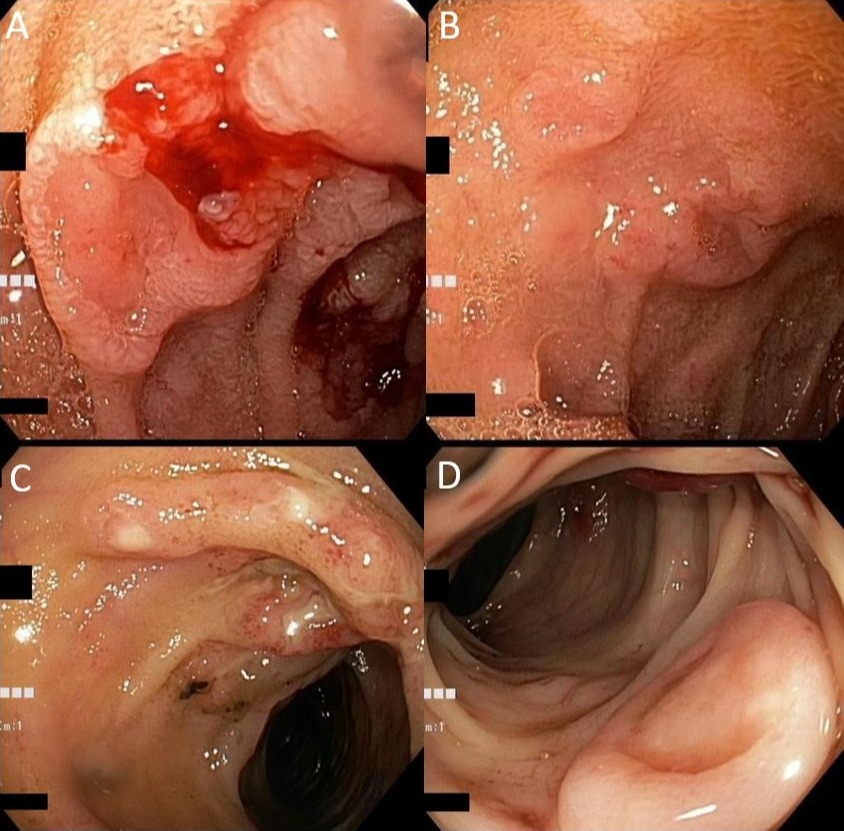Back
Poster Session A - Sunday Afternoon
A0301 - An Unusual Cause of Gastrointestinal Blood Loss Anemia: Post-Transplant Lymphoproliferative Disorder of the Small and Large Intestines
Sunday, October 23, 2022
5:00 PM – 7:00 PM ET
Location: Crown Ballroom

Sohum Patwa, MD
Warren Alpert Medical School of Brown University
Providence, RI
Presenting Author(s)
Sohum Patwa, MD, Jason Ferreira, MD
Warren Alpert Medical School of Brown University, Providence, RI
Introduction: Post-transplant lymphoproliferative disorder (PTLD) is a lymphoma that can occur in immunosuppressed patients such as those post renal transplantation. It is linked to Epstein-Barr virus (EBV) positivity. Symptoms depend on the organ system affected. The rare manifestation of PTLD in the gastrointestinal tract can lead to abdominal pain and nausea. Gastrointestinal blood loss anemia can occur as a consequence of these lesions. We report the rare case of post-transplant lymphoproliferative disorder manifesting in the gastrointestinal tract requiring endoscopic evaluation and biopsy for diagnosis.
Case Description/Methods: A 27-year-old woman with a history of focal segmental glomerulosclerosis status post-renal transplantation, sleeve gastrectomy, hypertension, and immune thrombocytopenia presented with abdominal pain, dizziness, and nausea. She denied hematochezia, melena, or vomiting. Vital signs were stable. Her physical exam was notable for diffuse abdominal tenderness. Labs were remarkable for a hemoglobin of 5.8 g/dL with a mean corpuscular volume of 89 fL.
She underwent an esophagogastroduodenoscopy (EGD) which was notable for patchy abnormal vascularity, congestion, and scalloped mucosal folds in the duodenum (Figures 1a and 1b). Colonoscopy revealed patchy ulceration with heaped-up margins and congestion in the terminal ileum and entire colon (Figures 1c and 1d). Biopsies were consistent with monomorphic post-transplant lymphoproliferative disorder with EBV positivity. She was subsequently referred to oncology for further management. She was treated with the drug combination R-CHOP. Repeat EGD and colonoscopy approximately one year later were notable for resolution of the lesions, though a positron emission tomography scan demonstrated persistence of disease in other organ systems.
Discussion: Abdominal pain, nausea, or blood loss anemia in a post-solid organ or stem cell transplant recipient should raise suspicion for post-transplant lymphoproliferative disorder with gastrointestinal manifestations. A high index of suspicion is required to make the diagnosis. This case highlights the role of early endoscopic evaluation and biopsy in establishing the diagnosis. The endoscopic appearance of PTLD in the small and large intestines varies but can include areas of scalloped mucosal folds with active bleeding along with areas of abnormal vascularity and congestion.

Disclosures:
Sohum Patwa, MD, Jason Ferreira, MD. A0301 - An Unusual Cause of Gastrointestinal Blood Loss Anemia: Post-Transplant Lymphoproliferative Disorder of the Small and Large Intestines, ACG 2022 Annual Scientific Meeting Abstracts. Charlotte, NC: American College of Gastroenterology.
Warren Alpert Medical School of Brown University, Providence, RI
Introduction: Post-transplant lymphoproliferative disorder (PTLD) is a lymphoma that can occur in immunosuppressed patients such as those post renal transplantation. It is linked to Epstein-Barr virus (EBV) positivity. Symptoms depend on the organ system affected. The rare manifestation of PTLD in the gastrointestinal tract can lead to abdominal pain and nausea. Gastrointestinal blood loss anemia can occur as a consequence of these lesions. We report the rare case of post-transplant lymphoproliferative disorder manifesting in the gastrointestinal tract requiring endoscopic evaluation and biopsy for diagnosis.
Case Description/Methods: A 27-year-old woman with a history of focal segmental glomerulosclerosis status post-renal transplantation, sleeve gastrectomy, hypertension, and immune thrombocytopenia presented with abdominal pain, dizziness, and nausea. She denied hematochezia, melena, or vomiting. Vital signs were stable. Her physical exam was notable for diffuse abdominal tenderness. Labs were remarkable for a hemoglobin of 5.8 g/dL with a mean corpuscular volume of 89 fL.
She underwent an esophagogastroduodenoscopy (EGD) which was notable for patchy abnormal vascularity, congestion, and scalloped mucosal folds in the duodenum (Figures 1a and 1b). Colonoscopy revealed patchy ulceration with heaped-up margins and congestion in the terminal ileum and entire colon (Figures 1c and 1d). Biopsies were consistent with monomorphic post-transplant lymphoproliferative disorder with EBV positivity. She was subsequently referred to oncology for further management. She was treated with the drug combination R-CHOP. Repeat EGD and colonoscopy approximately one year later were notable for resolution of the lesions, though a positron emission tomography scan demonstrated persistence of disease in other organ systems.
Discussion: Abdominal pain, nausea, or blood loss anemia in a post-solid organ or stem cell transplant recipient should raise suspicion for post-transplant lymphoproliferative disorder with gastrointestinal manifestations. A high index of suspicion is required to make the diagnosis. This case highlights the role of early endoscopic evaluation and biopsy in establishing the diagnosis. The endoscopic appearance of PTLD in the small and large intestines varies but can include areas of scalloped mucosal folds with active bleeding along with areas of abnormal vascularity and congestion.

Figure: A: second part of duodenum and B: duodenal bulb demonstrating scalloped mucosal folds. C: terminal ileum and D: descending colon with congestion and ulceration with heaped-up margins
Disclosures:
Sohum Patwa indicated no relevant financial relationships.
Jason Ferreira indicated no relevant financial relationships.
Sohum Patwa, MD, Jason Ferreira, MD. A0301 - An Unusual Cause of Gastrointestinal Blood Loss Anemia: Post-Transplant Lymphoproliferative Disorder of the Small and Large Intestines, ACG 2022 Annual Scientific Meeting Abstracts. Charlotte, NC: American College of Gastroenterology.

